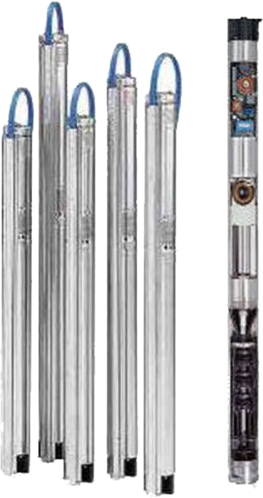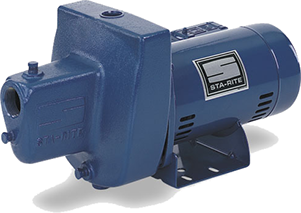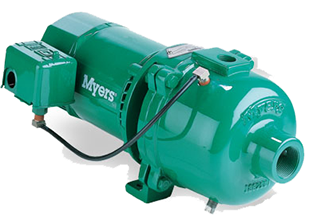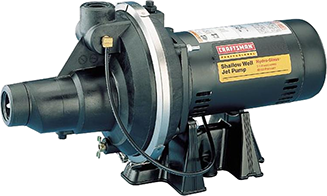These systems have been widely available since the early 1940's. Today, in Wisconsin, they are most frequently found in easy to drill formations where shallow water is plentiful. They offer a mechanism for some to more easily provide their own water supply.
These pump systems are most often paired with driven points---either using 1.25" or 2" galvanized steel pipe or on a jetted 2" well using a 1.25" screen telescoped beyond the end of the 2" casing. The latter type here in Wisconsin is only allowed to be constructed for hire by a licensed well driller.







Typical Pumphouse required for jet pump freeze protection.
Typical 2" pitless adapter.
Jet pump with a seal cross (seen at left), Box elbow and Pitless adapter (not shown).
Vertical multi-stage deep well jet pump.
Homeowner installed shallow well jet pump.
Non-code compliant shallow well jet pump. (Note unprotected buried suction line.)
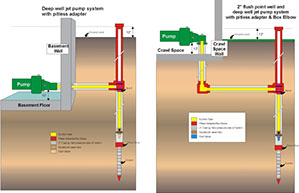
2" Well and Jet pump Systems
Click on the drawing below to see a cross section of how your 2" well is possibly constructed. It may also look the same at the surface when constructed with a driven point, however, the point in that case would not be repairable without removing the casing.
"Jet Pump Systems", or "Centrifugal Pump Systems" (they do not all use jets) are typically installed on either 2' wells or driven points. They are divided into two different categories, "SHALLOW WELL" and "DEEP WELL" systems. Those names actually have nothing to do with the actual depth of the well, rather they describe how the pump lifts the water. See below for more information.
Imagine placing a straw in a glass of soda. As you sip on the straw, you are creating a low pressure area---a small vacuum---relative to the atmospheric pressure that is surrounding you, or the air pressure on the outside of the straw. That relatively greater air pressure all around you is what then pushes the soda up the straw. That is essentially how a shallow well jet pump works.
Many people choose to drive their own well point, and this is the type of pump system most commonly used.
Water has weight. If you dive for pennies in the shallow end of a swimming pool, you don't it notice much. Dive to the bottom of the 12' end and you can feel the difference. Every 2.31 foot of water = 1 pound per square inch (psi) of pressure. Lift a column of water 23.1 feet = 10 psi. You are constantly surrounded by about 14 psi of atmospheric pressure. You take away ALL of that 14.7 psi (at sea level) and the difference in pressure created by that vacuum will allow you to lift a column of water about 33 feet into the air.
Even if you create a perfect vacuum, however, you cannot suction lift a column of water more than about 33 feet at sea level. It does not matter how big your pump is! The pump cannot ever create more of a vacuum than a vacuum! Geographically here in Wisconsin, it's an average of about 900' above sea level. That means that the air here is just a little "thinner" air than at sea level. A little less atmospheric pressure to push the water up the pipe. Add the fact that a jet pump does not even come close to creating a perfect vacuum and you find that the efficient, or practical limit to the shallow well pump is about 24'. The deeper it is to water, the less efficient it is to lift the water, the more difficult it is to prime the pump, the less volume you get once the pump is finally primed.
Click here to see a chart of practical lift of shallow well pumps.
If your pump is located in your basement or crawl space, you are still required to have it connected by use of concentric piping and a Pitless Adapter. You can see an example of how it needs to be hooked up here.
What if it is farther than about 24 feet to water? In that case, if you choose to use a 2" well, you must use a Deep Well Jet Pump or construct a larger diameter well that will allow the use of a submersible pump system.
Deep Well Jet Pump Operation
Have you ever taken a garden hose with a nice nozzle attached and shot a stream of water across the lawn? Have you ever sprayed off a concrete sidewalk, or the bed of a truck? If you notice a puddle of water there, you can use the water spray to "push" the puddle away. In concept, that is how a deep well jet pump system works. It uses water forced through a venturi nozzle and venturi tube to push water that it draws in from below. Remember that you can never create a suction of more than 14.7 psi @ sea level. Imagine a garden hose with only 14 psi. That is not much pressure. On the other hand, some deep well jet pumps build well in excess of 100 psi! Those multi-stage jet pumps are designed to lift water that is quite deep. In the 50's and 60's, there was not much choice. Today, in most cases, it is much more efficient to use a submersible pump system.
The center pipe (commonly known as drop pipe) is suction. The annular space between the drop pipe & well casing is pressurized by the pump, similar to the garden hose analogy mentioned above.
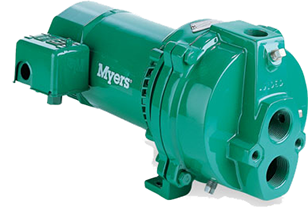
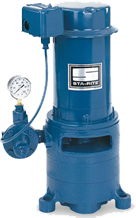
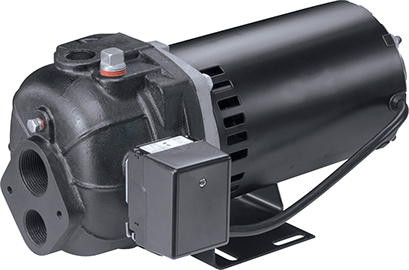
Note the double water opening.
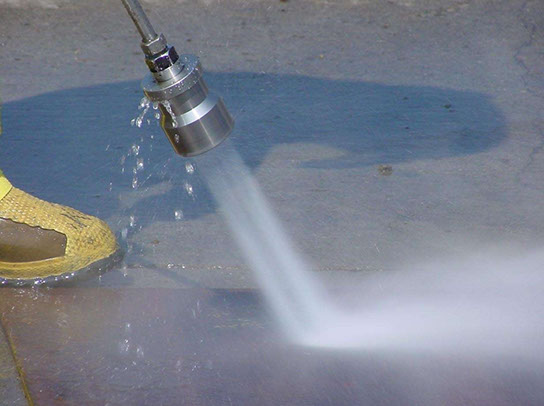
Water under pressure is used to move water in a Deep Well Jet Pump System.
An off-set pump hooked to a well with a buried suction line in Wisconsin must be connected to a Pitless Adapter using concentric piping. View a diagram here.

SUBMERSIBLE PUMPS are superior to jet pumps in virtually every category. They never need to be primed, because they are always immersed in water. They develop more pressure than a centrifugal or jet pump for the same rated horse power. The system is quieter than having the pump located in your basement or crawl space. The motor is cooled more efficiently by the cold well water than a jet pump is by the circulating air. The entire pump hook-up is less complicated and easier to maintain. The submersible pump is protected from freezing as it is down in the well. It is easier to push water than pull it. For the past 40-50 years, it has been the optimum way to supply your home with well water!
Submersible pumps simply gives you more water, less worry, costs less money to maintain and operate. Learn more about these systems here.
There is no quiz at the end of this page. Submersible or jet, it's your decision. Now you can make the right decision for you!
For JET PUMP SYSTEMS connected directly to the well, you will need a pump house and heat it in the winter. SUBMERSIBLE PUMP SYSTEMS do not need to be enclosed within a pump house.
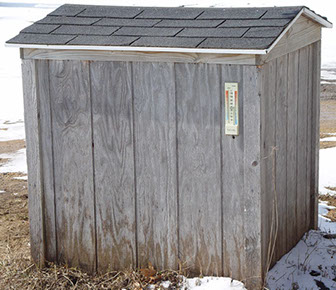
DO NOT GO BUY A NEW PUMP!
At least not until you talk with us! Just picture the straw analogy at the top of this page. If you are drinking a strawberry shake instead of a soda and get a strawberry stuck in the end of the straw, it does not matter how hard you try, you cannot draw any shake! Likewise, if your 2" well has a plugged screen (the inlet at the bottom of your well), your low water pressure is likely not your pumps fault! It does not matter how big or powerful or new your pump is, if your source is restricted, you are thwarted. Your well screen may be able to be repaired. See our troubleshooting or repairs pages.

